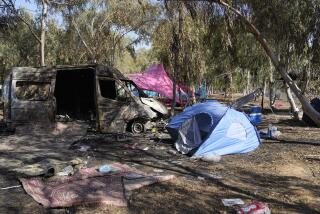Reaching Out to Acid-Attack Victims
- Share via
DHAKA, Bangladesh — In a darkened, airless workshop off an alleyway in a Dhaka suburb, four young women, along with a dozen other workers, assemble light bulbs from spare parts.
One woman stands over a wooden table and makes bulb filaments--straightening pieces of thin wire with a tweezer. She has a white gauze bandage around her neck and chemical burns on the right side of her face.
Her name is Nayan, and the story she tells, while horrific, is a tale of survival.
At 22, Nayan had been married for only three months when her factory-worker husband, Kabir, sent her to get money from her father, who earns $60 a month as an office assistant in a southern town.
“When I went to my father and asked him for the money, he said I had better leave my husband and return home,” Nayan explains.
“That night, I was sitting on a bed near an open window. Suddenly, I felt a splash of hot water on my face, neck and back and I started screaming in pain,” Nayan said.
What Nayan thought was hot water was really an acid that causes skin and flesh to melt and dissolves eyes and soft bones.
“My husband did this to me when my father could not pay him the 20,000 taka [$400] he demanded as dowry,” Nayan said, tears drizzling from her eyes.
Nayan is one of 441 victims who have been maimed or disfigured by acid in the last two years. She belongs to a small group of survivors who are working to reclaim their lives with help from the Acid Survivors Foundation, which offers medical care, counseling, physiotherapy, rehabilitation and legal support to acid victims.
The ASF arranged for Nayan to come to Dhaka and paid for her treatment at a private hospital. She had her latest surgery, a skin graft on her neck, in May.
“A woman who is attacked will probably not get married and will have to support herself. So we help them to get back on their feet,” said Dr. John Morrison, the foundation’s executive director.
Most acid victims are young women, attacked by spurned suitors or husbands seeking revenge. Many are left with scars from lack of specialized treatment and are often abandoned or ostracized by their families and communities.
The foundation, which celebrated its second anniversary in May, has helped 50 young women complete their education, given small-business loans to 10 and trained and found jobs for 14 others in offices or factories.
With little education and in need of money, Nayan opted for the job at Farzana Electric Lamps company, a small factory at Mirpur. She is paid $30 a month, given free lodging and on-the-job training.
“I have five younger sisters and no brothers, so I must work to help out my parents and support myself,” she said.
“I have got used to the heat and fumes [from the machines]. I do not have any skills. Who else would employ me?” she said.
The ASF is paying the factory owner to train Nayan and three other acid survivors so they can find better jobs, ASF rehabilitation officer Farzana Majid said.
In an air-conditioned office of the ASF across town, a 20-year-old woman named Fazila leafs through a pile of paper at her desk. Her face is covered with scabs; the skin around her lips and jaws sag like an old woman’s.
“A neighbor sprayed me with acid when I would not go out with him,” she said.
Fazila, who works for the ASF recording new attacks, drafting letters, preparing case files and doing follow-up reports, was an honor student preparing for her college entrance exams when she was attacked at home in a town near Dhaka. The ASF paid for her treatment, sponsored her for a computer training course and gave her a job.
“I wanted to study computer science. Now I am earning some money so I can finish my education,” she said.
A small bottle of acid, usually nitric or sulfuric, costs less than 1 cent and can be easily bought from auto repair garages, weavers, tanneries, goldsmiths or hardware stores.
The attackers usually target the victim’s face, breasts or genitals.
“There is violence against women everywhere, but here we have acid violence. In some cases, it is worse than death as it damages a woman for life,” Morrison said.
According to a national database kept by ASF, 97 acid attacks were recorded between January and May, 221 cases in all of 2000. About 78% of the victims were women, 41% under 18.
Although a 2000 law provides the death penalty or life imprisonment for acid attacks, only 10% of cases were tried in the past two years, with nine convicted and sentenced to death and another 25 sentenced to life in prison. Lawyers and victims blame the delay on a slow legal process and official corruption.
Nayan’s husband is in custody awaiting trial. Fazila’s neighbor was tried and sentenced earlier this year to 14 years in prison.
More to Read
Sign up for Essential California
The most important California stories and recommendations in your inbox every morning.
You may occasionally receive promotional content from the Los Angeles Times.













